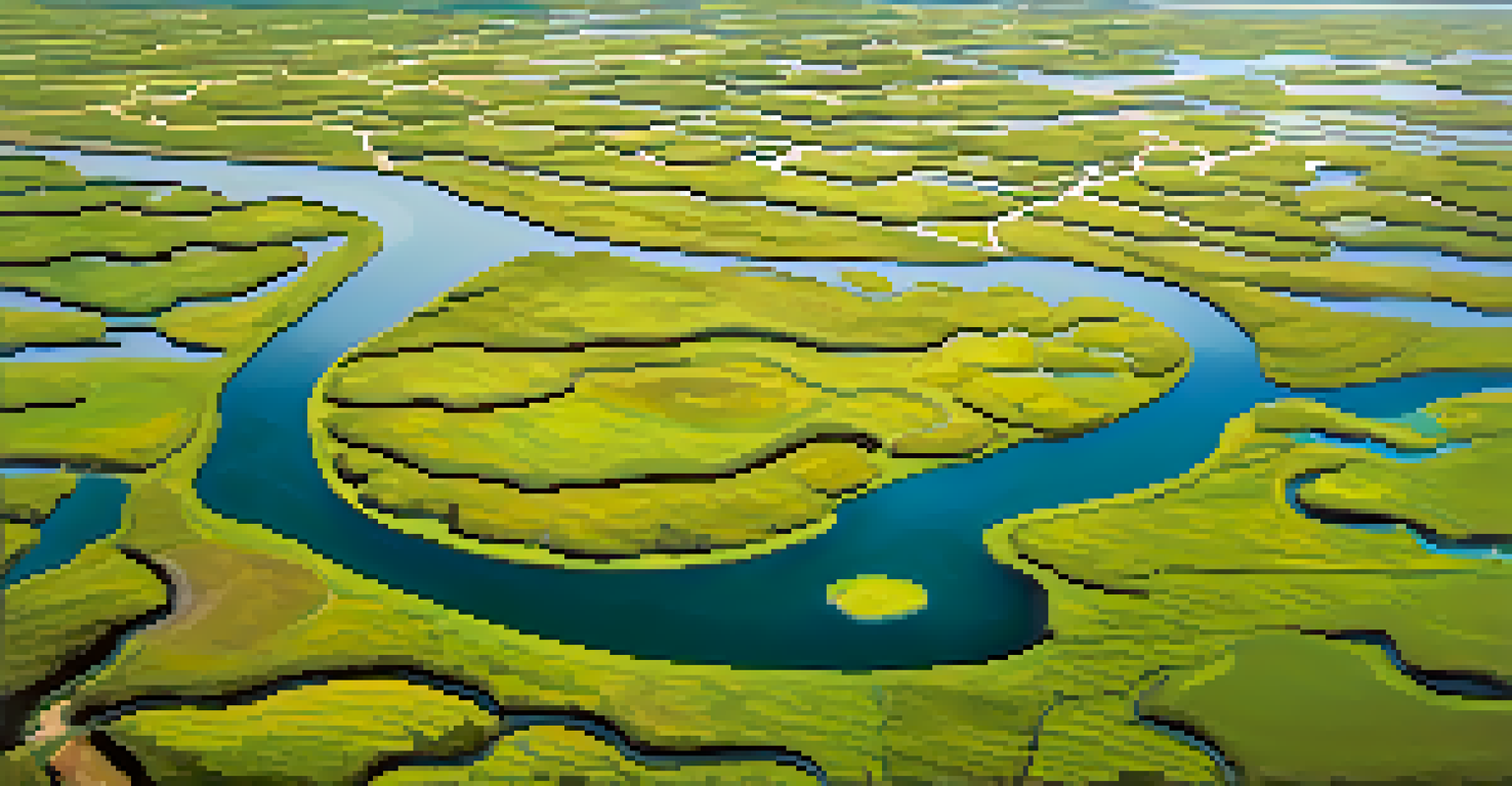Impact of Climate Change on San Francisco's Coastal Ecosystems

Understanding Coastal Ecosystems in San Francisco
San Francisco's coastal ecosystems are vibrant and diverse, encompassing wetlands, beaches, and rocky shores. These areas provide crucial habitats for various species, including birds, fish, and marine mammals. They also serve as natural buffers against storms and rising sea levels, making them vital for both wildlife and human communities.
The environment is where we all meet; where we all have a mutual interest; it is the one thing all of us share.
The interconnectedness of these ecosystems means that changes in one area can ripple throughout the environment. For instance, healthy wetlands filter pollutants and provide nursery grounds for fish, which in turn support local fishing industries. As these ecosystems face threats, the entire community feels the impact.
In essence, understanding these coastal ecosystems is the first step in recognizing the importance of protecting them against climate change. Each element plays a role in maintaining the balance that supports both nature and human life along the coast.
The Rising Threat of Sea Level Rise
One of the most pressing issues stemming from climate change is the rising sea levels. Globally, sea levels have risen due to melting ice caps and the thermal expansion of seawater, and San Francisco is no exception. Areas like Mission Bay and the Embarcadero are particularly vulnerable, facing increased flooding and erosion.

As sea levels rise, saltwater encroaches on freshwater habitats, disrupting the delicate balance of the coastal ecosystems. For example, salt marshes that once thrived may become submerged, leading to a loss of habitat for species that rely on these areas for survival. This shift can have cascading effects on the food chain and local biodiversity.
Coastal Ecosystems Are Vital
San Francisco's coastal ecosystems provide essential habitats and serve as natural buffers against climate change impacts.
Mitigating the effects of rising sea levels requires proactive measures, including restoring natural barriers and implementing smart development practices. By investing in these solutions, San Francisco can better protect its coastal ecosystems and the communities that depend on them.
Ocean Acidification and Its Impacts
Ocean acidification is another critical consequence of climate change that affects coastal ecosystems. As the atmosphere warms, oceans absorb more carbon dioxide, leading to a decrease in pH levels. This change can have devastating effects on marine life, particularly organisms with calcium carbonate shells, such as oysters and clams.
We won't have a society if we destroy the environment.
In San Francisco, the local fishing industry relies heavily on these shellfish, making the impacts of ocean acidification particularly concerning. With declining populations of these species, not only does it threaten the ecosystem balance, but it also jeopardizes the livelihoods of those who depend on fishing for their income.
Addressing ocean acidification requires a collective effort to reduce greenhouse gas emissions and promote sustainable fishing practices. By safeguarding these vulnerable species, we can help preserve the integrity of San Francisco's coastal ecosystems.
Changing Weather Patterns and Coastal Habitats
Climate change also alters weather patterns, resulting in more frequent and intense storms. These extreme weather events can lead to significant erosion along San Francisco's coastline, destroying habitats and displacing wildlife. The impacts of these storms are felt not just in the natural world but also in local communities that rely on these ecosystems for recreation and tourism.
In addition, changing precipitation patterns can affect the freshwater supply that supports coastal ecosystems. For example, prolonged droughts may reduce the flow of rivers that feed into wetlands, disrupting the delicate balance of salinity and habitat health. This imbalance can lead to die-offs of sensitive species and a decline in overall biodiversity.
Rising Sea Levels Threaten Habitats
As sea levels rise, saltwater intrusion disrupts delicate coastal ecosystems, jeopardizing local biodiversity and communities.
To combat these challenges, it is essential to develop resilient coastal management strategies. By restoring habitats and implementing sustainable land-use practices, San Francisco can better withstand the impacts of changing weather patterns and protect its coastal ecosystems.
Wildlife Adaptation to Climate Change
As climate change reshapes their environment, wildlife in San Francisco's coastal ecosystems must adapt to survive. Some species may migrate to cooler areas or shift their breeding seasons to align with changing food availability. However, not all species can adapt quickly enough to keep pace with the rapid changes occurring.
For instance, iconic species like the California sea lion and the western snowy plover face increased challenges as their habitats become less suitable due to rising sea levels and altered food sources. Conservation efforts must focus on protecting these vulnerable species and their habitats to ensure their survival.
Promoting biodiversity through habitat restoration and providing corridors for wildlife movement are crucial steps in helping species adapt. By fostering resilience in these ecosystems, we can support the wildlife that calls San Francisco's coast home.
Community Impact and Engagement
The effects of climate change on coastal ecosystems extend beyond the environment; they also significantly impact local communities. Residents who live near the coast may experience increased flooding, loss of recreational areas, and declines in property values. These changes can create a sense of loss and urgency in addressing climate issues.
Community engagement is essential for addressing these challenges effectively. Local organizations and residents can collaborate on restoration projects, educational initiatives, and advocacy efforts to promote awareness about the importance of coastal ecosystems. By fostering a sense of stewardship, communities can work together to create a more resilient future.
Community Engagement is Key
Involving local communities in conservation efforts is crucial for building resilience against climate change impacts on coastal ecosystems.
Moreover, integrating community voices in decision-making processes helps ensure that solutions reflect the needs and values of those most affected. By empowering residents, San Francisco can build a strong foundation for combating the impacts of climate change.
The Role of Policy and Conservation Efforts
Effective policy and conservation efforts are crucial for protecting San Francisco's coastal ecosystems from climate change. Local governments, non-profits, and community organizations must collaborate to create comprehensive strategies that address both immediate and long-term challenges. This includes funding for habitat restoration, sustainable land-use planning, and climate resilience initiatives.
For example, establishing marine protected areas can help safeguard vital habitats by limiting human activities that contribute to degradation. These areas serve as safe havens for marine life while allowing ecosystems to recover and thrive. Policymakers must prioritize these efforts to ensure the health of coastal ecosystems.

Additionally, educating the public about the importance of these policies can foster greater community support and involvement. By working together, San Francisco can create a robust framework for conservation that not only protects coastal ecosystems but also enhances the quality of life for all residents.